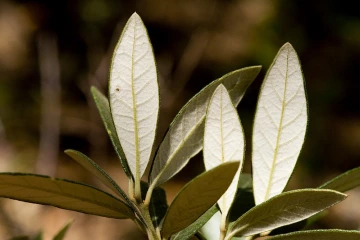
Cecelia Alexander Flickr.com
Botanical Family: Fagaceae
Scientific Name: Quercus hypoleucoides
Common Names: silverleaf oak
Botanical Description:
Quercus hypoleucoides is a medium size, evergreen tree, or large shrub, typically growing to 10-18 meters in height with a round, spreading crown, at elevations of 3,600-9,000 feet (1,2). Taller specimens have been recorded, however, at heights of up to 26 meters tall (2). The species is typically found in dry, open areas (2). The bark is black and deeply furrowed (1). Young branches are dark reddish-brown and woolly early in the season, but become glabrous later in the summer (1). Older branches are gray and somewhat smooth (1). The thick, leathery leaves are 4-11cm long, slender and oblong to lanceolate in shape with revolute, unlobed to mildly toothed leaf margins (1,2). The leaves are held by 3-11 mm long, woolly petioles (1). The upper surface of the leaves is dark green and shiny, while the underside is white and densely covered with stellate-tomentose hairs (1,2). The flowers, which develop from March to May, are mostly wind-pollinated, and unisexual, with reduced or absent petals (1). Staminate flowers are catkins with 4-6 stamens (1). Pistillate flowers appear singly, or in clusters of 3 or more, each of which develops into a cupule (cup-shaped structure) that encloses 1/3 of the fruit if fertilization of the pistillate flowers has occured (1). The fruits are 1.5-2 cm long chestnut brown, sometimes striped, acorns which remain on the tree and mature during the second summer after they’re produced (1,2).
Ecological Significance:
Quercus hypoleucoides is drought tolerant and resistant to low winter temperatures, making it adaptable to a wide range of habitats (2,3). It is often found in association with Pinus cembroides (pinyon pine), in pine-oak forests, canyons, woodlands, and grasslands (1,2). Oaks (Quercus spp.) are keystone species, supporting important food chains and ecological processes. They provide sustenance and shelter for a multitude of animals, plants, fungi, and insects (4,5). Their shade canopy and root systems support soil microbes and invertebrates as well (4,5).
Ethnobotanical Value:
This species is prized as an ornamental for its beauty and environmental adaptation (2,3,6). Quercus spp. are important medicinal plants widely used in traditional medicine (7). Nearly all parts of the plants, including fruit, bark, and leaves, possess medicinal properties. Indigenous tribes used the plant as an antiseptic, and for treatment of gastrointestinal tract disorders (7). The bark, prepared as a tea for internal use, or an ointment for topical application, purportedly has antiseptic properties, and is used as a blood-clotting agents, and in the treatment of toothaches, inflammation, and burns (7,8,9). However, further research is necessary to confirm these benefits and identify all possible side effects of use (9). The fruits of Quercus spp. are generally rich sources of nutrients, containing high levels of carbohydrates, proteins, amino acids, lipids, and sterols (7).
Distribution:
Arizona, New Mexico, Texas, Northern Mexico

